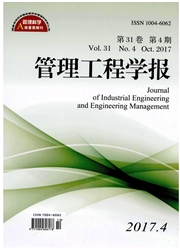

 中文摘要:
中文摘要:
以全球环境下的一个由上游制造商和下游零售商组成的二级供应链为建模背景,建立了动态博弈模型,获得了均衡结果,并对均衡进行了比较静态分析,研究了汇率的不确定性、外生需求对风险对冲策略和批发价格的影响方式。结果表明:在均衡下,汇率的外生波动性的增加将导致制造商的汇率风险暴露比例降低,当制造商的风险规避系数足够大时,需求的外生波动性的增加将导致制造商的汇率风险暴露比例降低;汇率和需求的外生波动性的增加均会导致批发价格的降低。数值分析结果表明:在均衡下,汇率和需求的外生波动性的增加均会导致制造商利润的方差和期望值的降低,以及零售商利润的方差和期望值的增加。这表明,一方面,汇率风险通过批发价在供应链节点间向下传递,需求风险通过订货量向上传递;另一方面,制造商的汇率风险对冲策略能够实现风险承担与收益之间的权衡(即获取高收益对应着承担高风险)。
 英文摘要:
英文摘要:
This paper mainly focuses on the risk management problem of a two-echelon global supply chain consisting of an upstream manufacturer facing with the exchange rate risk and a downstream retailer facing with the demand risk. In the supply chain, the manufacturer sells its product to the retailer via a wholesale price contract signed according to the retailer's currency and retailer sells in the final market. The demand risk roots in the uncertainty of final market demand while the exchange rate risk stems from the assumption that the manufacturer and the retailer operate in different counties and then the manufacturer's revenue per product sale suffers from the fluctuations of exchange rate. To hedge the exchange rate risk, the manufacturer buys the foreign exchange futures in futures market. We model the manufacturer's exchange rate risk-hedging decision as choosing a proportion of its revenue exposed to the exchange rate risk. In the standard wholesale price contract framework, this paper establishes a two-stage dynamic game model between the manufacturer and the retailer. The manufacturer offers a wholesale price to the retailer and decides its exchange rate risk-hedging decision in the first stage while given the wholesale price. The retailer follows to decide its order quantity from the manufacturer in the second stage. With this model, we calculate the subgame perfect equilibrium and conduct comparative static analysis on how the risks caused by the exchange rate and final market demand volatility influence the manufacturer's equilibrium risk-hedging decision and wholesale price. The analytical results show that in equilibrium, the proportion of the manufacturer's revenue that exposes to the exchange rate fluctuations decreases in both the exchange rate volatility and the final market demand volatility when the manufacturer's risk aversion coefficient is high enough. We also find that the equilibrium wholesale price decreases in these two kinds of risks. Furthermore, this paper investigates how
 同期刊论文项目
同期刊论文项目
 同项目期刊论文
同项目期刊论文
 Coordination of outsourced operations at a third-party facility subject to booking, overtime, and ta
Coordination of outsourced operations at a third-party facility subject to booking, overtime, and ta Optimal policies in hybrid manufacturing/remanufacturing systems with random price-sensitive product
Optimal policies in hybrid manufacturing/remanufacturing systems with random price-sensitive product Forecast and Rolling Horizons under Demand Substitution and Production Changeovers Analysis and Insi
Forecast and Rolling Horizons under Demand Substitution and Production Changeovers Analysis and Insi On consensus of group decision making with interval utility values and interval perference orderings
On consensus of group decision making with interval utility values and interval perference orderings A tabu search algorithm with solution space partition and repairing procedure for cyclic robotic cel
A tabu search algorithm with solution space partition and repairing procedure for cyclic robotic cel Social responsibility allocation in two-echelon supply chains: Insights from wholesale price contrac
Social responsibility allocation in two-echelon supply chains: Insights from wholesale price contrac Optimal acquisition and production policy in a hybird manufacturing/remanufacturing system with core
Optimal acquisition and production policy in a hybird manufacturing/remanufacturing system with core Optimal Manpower Planning Decision with Single Employee Type Considering Minimal Employment Period C
Optimal Manpower Planning Decision with Single Employee Type Considering Minimal Employment Period C Optimal Solution Structure for Multi-period Prodution Planning with Returned Products Remanufacturin
Optimal Solution Structure for Multi-period Prodution Planning with Returned Products Remanufacturin 期刊信息
期刊信息
